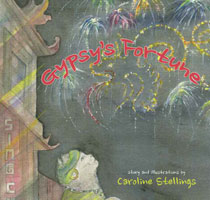| ________________
CM . . .
. Volume XXI Number 29 . . . . April 3, 2015
excerpt:
Gypsy is a fortune-telling cat living in San Francisco in the 1920s. When the city elects a new mayor, he outlaws fortune-telling for money, and Gypsy suddenly finds herself out of work. Unable to charge for reading palms, crystal-gazing, or telling fortunes, Gypsy wanders the city, looking for a new job. But when she discovers a small Chinese restaurant about to go out of business, she teams up with the owner to bring in new customers by offering fortunes stuck inside cookies that are free with every meal. The text of this story is written mostly in rhyming couplets, with certain key scenes breaking from this pattern, such as when Gypsy first slips a fortune into the restaurant owner’s cookie, one that tells him not to sell his establishment. Since the majority of the text rhymes, however, the flow of the story has a nice bounce, making it well-suited for reading aloud. Stellings’ watercolour illustrations have an almost faded appearance that is perfect for Gypsy’s Fortune’s 1920s setting. The gentle lines and subdued colours give the story a quiet, reflective feel, with the use of soft greys, pinks, and yellows throughout the book creating a hazy quality in many of the illustrations. The effect is that Gypsy’s Fortune reads like a tale straight from someone’s family past, with the full-page pictures acting as vivid memories of a bygone era. There is also a bit of added fun with the illustrations in this book as on every page of text there is a watercolour fortune cookie painted in the bottom corner. Each cookie includes a traditional fortune, including sayings like “Patience–in time the grass becomes milk” and “Happiness is not perfect unless it is shared”. No one knows exactly where fortune cookies originated, but it is believed that early 20th century California is where this delightful and delicious trend began. Gypsy’s Fortune gives one possible explanation for how strict city laws may have created a new method of telling fortunes, and through its sweet account of events, Stellings’ tale offers readers a fascinating introduction to the mysterious history of the fortune cookie. Highly Recommended. Meredith Cleversey is a librarian in Cambridge, ON. She loves to read, write, and live in a world of pure imagination.
To comment on this title or this review, send mail to cm@umanitoba.ca.
Copyright © the Manitoba Library Association. Reproduction for personal use is permitted only if this copyright notice is maintained. Any
other reproduction is prohibited without permission.
CM Home | Next Review | Table of Contents for This Issue - April 3, 2015 | Back Issues | Search | CM Archive | Profiles Archive |
